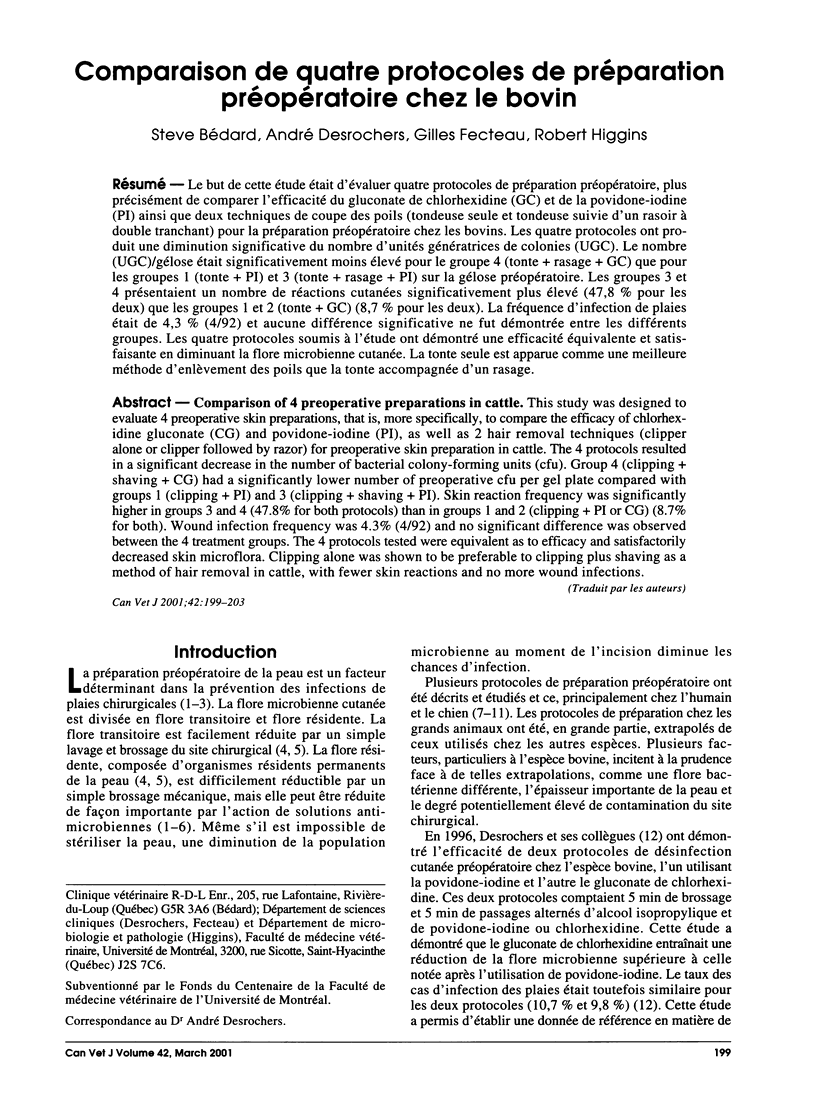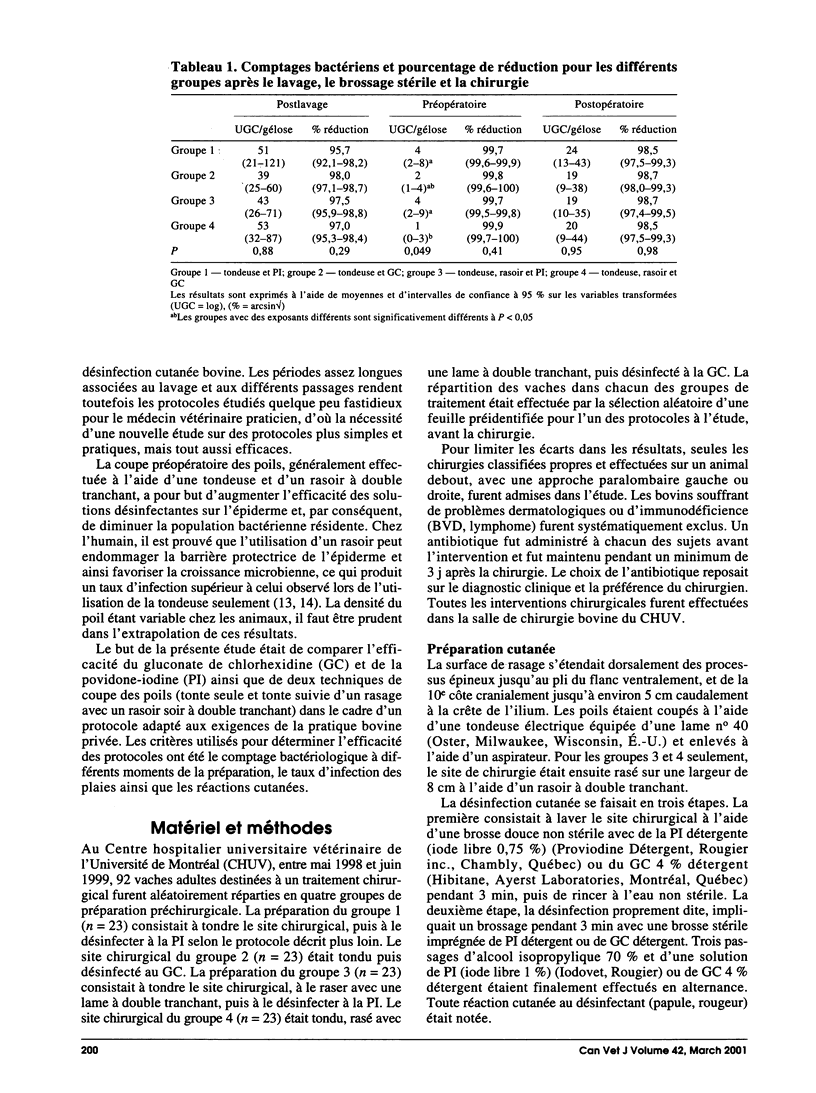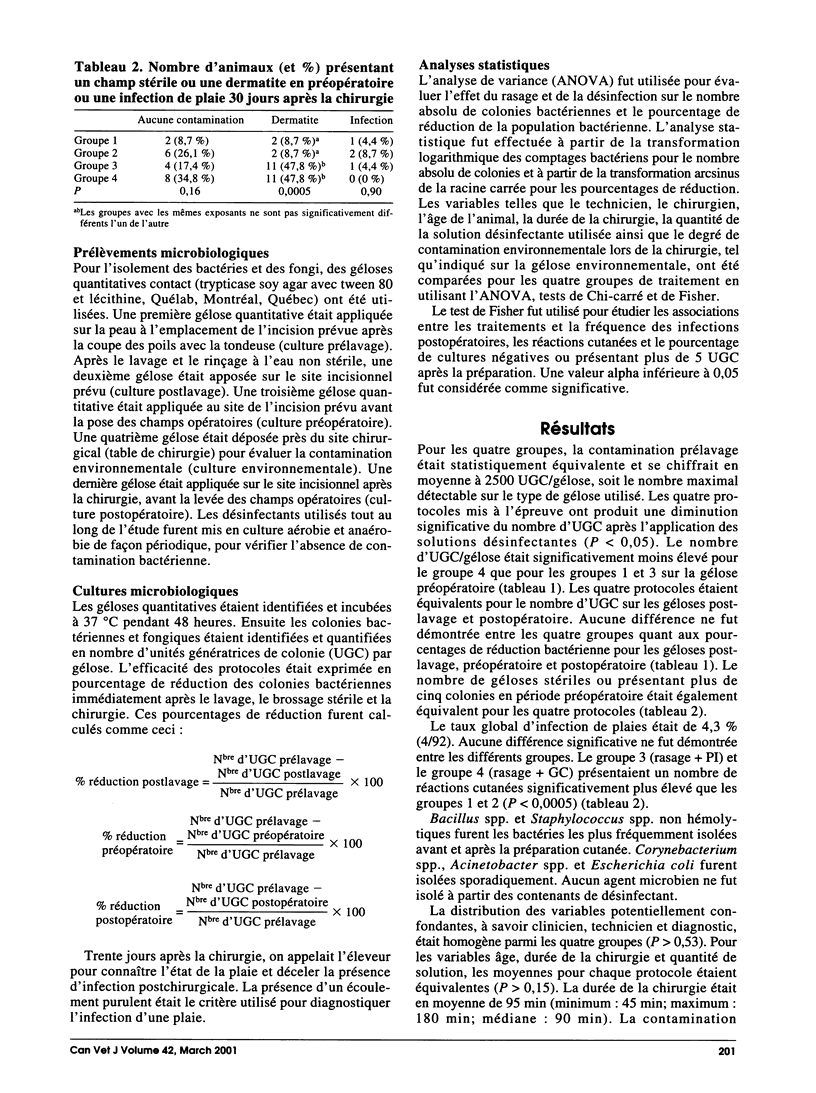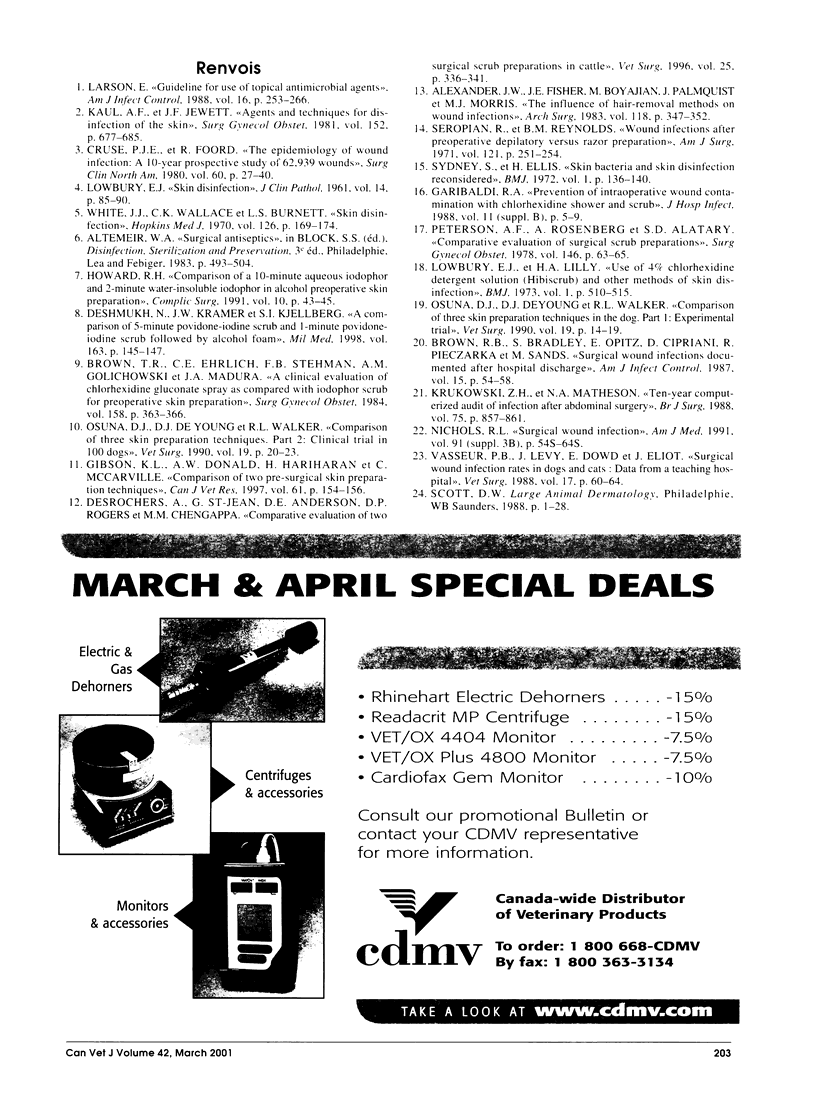Abstract
This study was designed to evaluate 4 preoperative skin preparations, that is, more specifically, to compare the efficacy of chlorhexidine gluconate (CG) and povidone-iodine (PI), as well as 2 hair removal techniques (clipper alone or clipper followed by razor) for preoperative skin preparation in cattle. The 4 protocols resulted in a significant decrease in the number of bacterial colony-forming units (cfu). Group 4 (clipping + shaving + CG) had a significantly lower number of preoperative cfu per gel plate compared with groups 1 (clipping + PI) and 3 (clipping + shaving + PI). Skin reaction frequency was significantly higher in groups 3 and 4 (47.8% for both protocols) than in groups 1 and 2 (clipping + PI or CG) (8.7% for both). Wound infection frequency was 4.3% (4/92) and no significant difference was observed between the 4 treatment groups. The 4 protocols tested were equivalent as to efficacy and satisfactorily decreased skin microflora. Clipping alone was shown to be preferable to clipping plus shaving as a method of hair removal in cattle, with fewer skin reactions and no more wound infections.
Full text
PDF




Selected References
These references are in PubMed. This may not be the complete list of references from this article.
- Alexander J. W., Fischer J. E., Boyajian M., Palmquist J., Morris M. J. The influence of hair-removal methods on wound infections. Arch Surg. 1983 Mar;118(3):347–352. doi: 10.1001/archsurg.1983.01390030079013. [DOI] [PubMed] [Google Scholar]
- Brown R. B., Bradley S., Opitz E., Cipriani D., Pieczarka R., Sands M. Surgical wound infections documented after hospital discharge. Am J Infect Control. 1987 Apr;15(2):54–58. doi: 10.1016/0196-6553(87)90002-2. [DOI] [PubMed] [Google Scholar]
- Brown T. R., Ehrlich C. E., Stehman F. B., Golichowski A. M., Madura J. A., Eitzen H. E. A clinical evaluation of chlorhexidine gluconate spray as compared with iodophor scrub for preoperative skin preparation. Surg Gynecol Obstet. 1984 Apr;158(4):363–366. [PubMed] [Google Scholar]
- Cruse P. J., Foord R. The epidemiology of wound infection. A 10-year prospective study of 62,939 wounds. Surg Clin North Am. 1980 Feb;60(1):27–40. doi: 10.1016/s0039-6109(16)42031-1. [DOI] [PubMed] [Google Scholar]
- Deshmukh N., Kramer J. W., Kjellberg S. I. A comparison of 5-minute povidone-iodine scrub and 1-minute povidone-iodine scrub followed by alcohol foam. Mil Med. 1998 Mar;163(3):145–147. [PubMed] [Google Scholar]
- Desrochers A., St-Jean G., Anderson D. E., Rogers D. P., Chengappa M. M. Comparative evaluation of two surgical scrub preparations in cattle. Vet Surg. 1996 Jul-Aug;25(4):336–341. doi: 10.1111/j.1532-950x.1996.tb01422.x. [DOI] [PubMed] [Google Scholar]
- Gibson K. L., Donald A. W., Hariharan H., McCarville C. Comparison of two pre-surgical skin preparation techniques. Can J Vet Res. 1997 Apr;61(2):154–156. [PMC free article] [PubMed] [Google Scholar]
- Kaul A. F., Jewett J. F. Agents and techniques for disinfection of the skin. Surg Gynecol Obstet. 1981 May;152(5):677–685. [PubMed] [Google Scholar]
- Krukowski Z. H., Matheson N. A. Ten-year computerized audit of infection after abdominal surgery. Br J Surg. 1988 Sep;75(9):857–861. doi: 10.1002/bjs.1800750909. [DOI] [PubMed] [Google Scholar]
- LOWBURY E. J. Skin disinfection. J Clin Pathol. 1961 Jan;14:85–90. doi: 10.1136/jcp.14.1.85. [DOI] [PMC free article] [PubMed] [Google Scholar]
- Larson E. Guideline for use of topical antimicrobial agents. Am J Infect Control. 1988 Dec;16(6):253–266. doi: 10.1016/s0196-6553(88)80005-1. [DOI] [PubMed] [Google Scholar]
- Lowbury E. J., Lilly H. A. Use of 4 per cent chlorhexidine detergent solution (Hibiscrub) and other methods of skin disinfection. Br Med J. 1973 Mar 3;1(5852):510–515. doi: 10.1136/bmj.1.5852.510. [DOI] [PMC free article] [PubMed] [Google Scholar]
- Nichols R. L. Surgical wound infection. Am J Med. 1991 Sep 16;91(3B):54S–64S. doi: 10.1016/0002-9343(91)90344-w. [DOI] [PubMed] [Google Scholar]
- Osuna D. J., DeYoung D. J., Walker R. L. Comparison of three skin preparation techniques in the dog. Part 1: Experimental trial. Vet Surg. 1990 Jan-Feb;19(1):14–19. doi: 10.1111/j.1532-950x.1990.tb01136.x. [DOI] [PubMed] [Google Scholar]
- Osuna D. J., DeYoung D. J., Walker R. L. Comparison of three skin preparation techniques. Part 2: Clinical trial in 100 dogs. Vet Surg. 1990 Jan-Feb;19(1):20–23. doi: 10.1111/j.1532-950x.1990.tb01137.x. [DOI] [PubMed] [Google Scholar]
- Peterson A. F., Rosenberg A., Alatary S. D. Comparative evaluation of surgical scrub preparations. Surg Gynecol Obstet. 1978 Jan;146(1):63–65. [PubMed] [Google Scholar]
- Selwyn S., Ellis H. Skin bacteria and skin disinfection reconsidered. Br Med J. 1972 Jan 15;1(5793):136–140. doi: 10.1136/bmj.1.5793.136. [DOI] [PMC free article] [PubMed] [Google Scholar]
- Seropian R., Reynolds B. M. Wound infections after preoperative depilatory versus razor preparation. Am J Surg. 1971 Mar;121(3):251–254. doi: 10.1016/0002-9610(71)90199-1. [DOI] [PubMed] [Google Scholar]
- Vasseur P. B., Levy J., Dowd E., Eliot J. Surgical wound infection rates in dogs and cats. Data from a teaching hospital. Vet Surg. 1988 Mar-Apr;17(2):60–64. doi: 10.1111/j.1532-950x.1988.tb00278.x. [DOI] [PubMed] [Google Scholar]
- White J. J., Wallace C. K., Burnett L. S. Skin disinfection. Johns Hopkins Med J. 1970 Mar;126(3):169–176. [PubMed] [Google Scholar]


